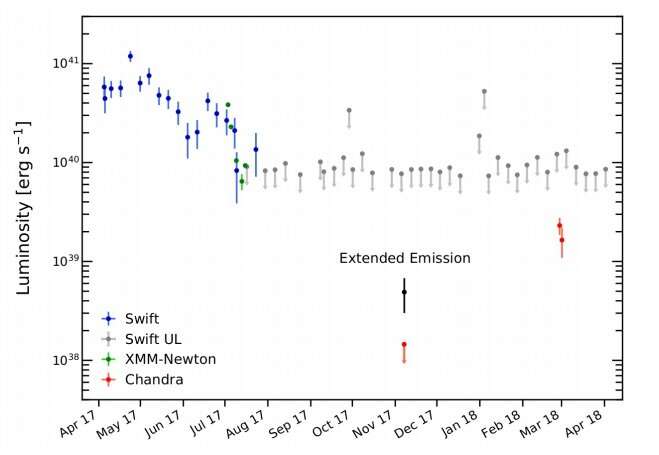November 5, 2019 report
Diffuse X-ray emission detected around the ultraluminous X-ray pulsar NGC 5907 ULX-1

Using NASA's Chandra spacecraft, European astronomers have detected a diffuse X-ray emission around an ultraluminous X-ray pulsar in the galaxy NGC 5907. The newly detected emission could be an expanding nebula powered by the wind of the pulsar. The finding is detailed in a paper published October 25 on the arXiv pre-print server.
Ultraluminous X-ray sources (ULXs) are point sources in the sky that are so bright in X-rays that each emits more radiation than 1 million suns emit at all wavelengths. Although they are less luminous than active galactic nuclei (AGN), they are more consistently luminous than any known stellar process.
Some ULXs showcase coherent pulsations. These sources, known as ultra-luminous X-ray pulsars (ULXPs), are neutron stars typically less massive than black holes. The list of known ULPs is still relatively short, hence detailed observations of so far detected objects of this class are essential for researchers studying the universe in X-rays.
NGC 5907 ULX-1 is an ULXP in the nearly edge-on spiral galaxy NGC 5907 located some 55.7 million light years away. The pulsar has a peak X-ray luminosity of more than 100 duodecillion erg/s and is driven by an accreting neutron star with a spin period of about one second.
Recently, a team of astronomers led by Andrea Belfiore of Institute of Space Astrophysics and Cosmic Physics of Milano, Italy, employed Chandra, ESA's XMM-Newton spacecraft and NASA's Neil Gehrels Swift Observatory, to take a closer look at NGC 5907 ULX-1. Results of Chandra observations reveal the presence of an extended diffuse X-ray emission around the source.
"During a Chandra observation to probe a low state of ULX1, we detected diffuse X-ray emission at the position of ULX1," the astronomers wrote in the paper.
The newly detected emission appears to be extended, with an observed disk radius of about 1.35 arcsecs. The feature was found to contains 25 photons, however none below 0.8 keV.
The astronomers assume that the identified structure is most likely an expanding nebula powered by the wind of NGC 5907 ULX-1. Such nebulae (also called bubbles) are generally attributed to shocks created by outflows from the binary system interacting with the surrounding medium.
"We assume that an isotropic wind with constant power Lw is emitted from the ULX system, shocks the external medium (ISM) and expands according to a self-similar solution. After a short free expansion period, the wind forms a shock that starts as adiabatic but becomes more and more radiatively efficient," the paper reads.
In the case of the supposed nebula around NGC 5907 ULX-1, the researchers found that it has a diameter of about 650 light years, characteristic energy of approximately 1.9 keV, and a luminosity at a level of 200 undecillion erg/s. Taking into account these results it was calculated that the nebula is around 70,000 years old and has a mechanical power of about 130 duodecillion erg/s.
More information: Diffuse X-ray emission around an ultraluminous X-ray pulsar, arXiv:1910.11876 [astro-ph.HE] arxiv.org/abs/1910.11876
© 2019 Science X Network





















